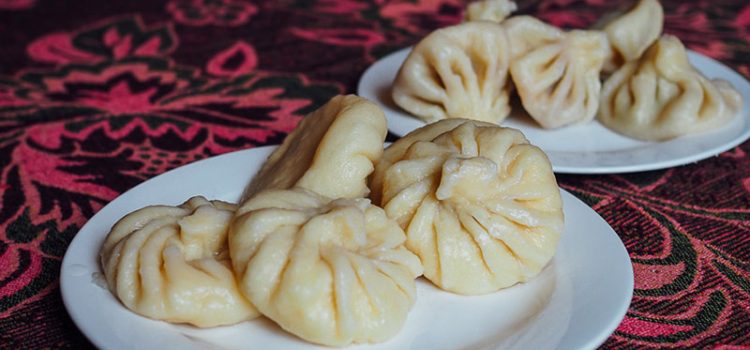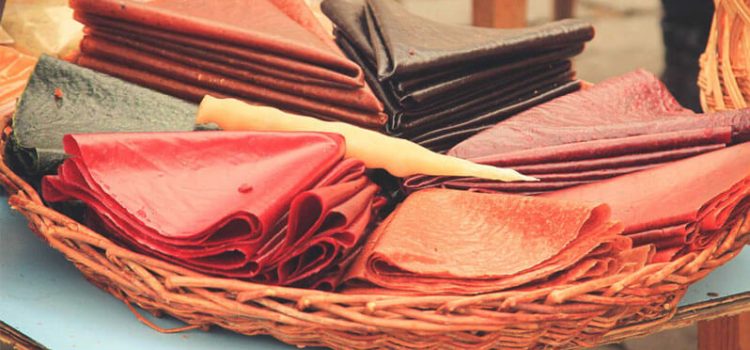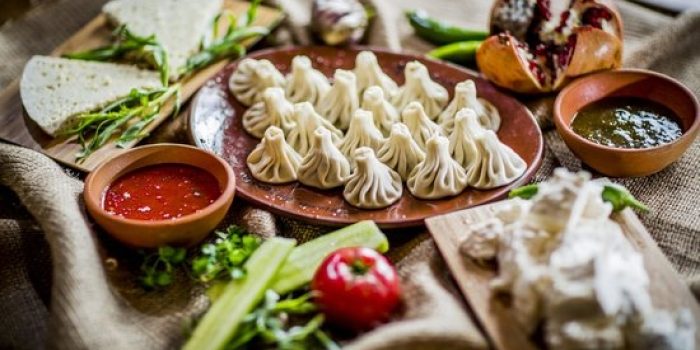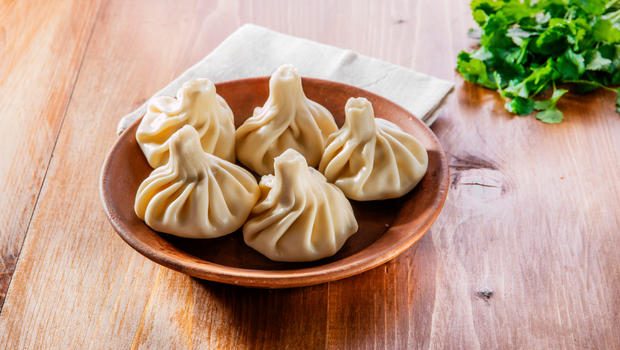Georgian restaurants in Kiev, Ukraine winning the hearts of their guests
Kyiv Post, Ukraine’s oldest English language newspaper has recently published an article about Georgian restaurants in Kiev. The article familiarizes the readers with particular Georgian flavor which was influenced by western and eastern traditions over the years.
“But Georgian cuisine has today developed its own unique flavor, and their khinkali (dumplings) and khachapuri (cheese bread) are the country’s calling cards.”
The first restaurant is Gogi (a Georgian male name) which offers a wide range of Georgian dishes, desserts and, wines accompanied by folk music playing background. Some of the dishes are Khinkali filled with meat, cheese, potato and mushrooms, Adjarian Khachapuri (a boat-shaped cheese bread) and Pkhali (a vegetarian appetizer).
The second restaurant is Suluguni (a type of Georgian cheese from the western region Samegrelo). The restaurant is located in the city center having a stylish design, a terrace, and lively Georgian music. The restaurant offers signature and classic Georgian dishes including a house-made drink such as a type of yogurt Matsoni.
The name of the third restaurant is very interesting – Oi, Mamo! Tse bulo v Tbilisi (Oh, Mom! It was in Tbilisi). The restaurant offers a wide choice of traditional Georgian dishes including, the kada dessert made with walnuts and cream. The legend behind the creation of the restaurants says that once a Kiev citizen visited Tbilisi, the capital of Georgia and was impressed by a Georgian family café – Tbilisi. Then the family moved to Kiev and opened the restaurant.
The restaurant Khinkali has five different zones for business meetings, celebrations or a summer terrace.
“The menu includes khinkali with various fillings: mutton and green adjika, veal and basil, veal tongue and mushrooms in a rich cream sauce, the classic mix of pork and veal, shrimps in cream sauce, and spinach and mushrooms.”
Besides, Khinkali offers the classic Adjarian khachapuri and the tasty pan-fried chicken tabaka.
The restaurant 99 Lari (“lari” is the name for Georgian currency) serve three types of Khachapuri boat-shaped Adjarian, circular Imeretian, and Megrelian, also circular, but sprinkled with cheese, kharcho soup with beef and tomatoes, Georgian desserts as well as vegetarian dishes such as roasted vegetables with walnut cream. 99 Lari gives out free drinks and appetizers from the chef.
And, lastly, Matsoni restaurant named after the Georgian yogurt “Matsoni”. The restaurant serves Matsoni made with fresh milk from small farms, Megrelian Khachapuri, chakhokhbili stewed turkey with fresh herbs and two varieties of Matsoni. The cozy atmosphere of the restaurant attracts guest on cold winter and fall days.
Source: Georgianjournal.ge
Georgian desserts to taste in winter
Georgia offers a whole range of local dishes. Georgian cuisine has been shaped by different cultures such as ancient Greek and Roman, middle eastern Turkish, central Asian, Mongolian, Russian and Indian influences.
If you plan to spend winter in Georgia, you are recommended to taste top Georgian desserts. You will not be able to find the same taste elsewhere in the world.
Pelamushi is a Georgian dessert made with pressed and condensed grape juice, sugar, and flour. The liquid is gradually
heated until it thickens, and it is then poured into serving dishes, bowls, or various molds, in order to create attractive shapes. When fully chilled, pelamushi is ready to be served, and it is recommended to garnish it with various nuts and seeds.
Churchkhela is a traditional Georgian candy that is shaped into a sausage. It originated from the Caucasus region. This candy is made by dipping a long string of nuts (usually walnut halves) in concentrated grape juice, then leaving the concoction to dry. It is quite healthy and so nutritious that it was even carried by Georgian warriors on their long journeys in the past. Although walnuts are mostly used in the preparation of churchkhela, they can be replaced by almonds, hazelnuts, or raisins.
Tklapi is a unique Georgian dessert consisting of cooked fruit puree that is poured on a tray in a very thin layer and left to dry in the sun for a few days. It is typically prepared with fruits such as wild plums, pears, mulberry, figs, or apples. Visually, this healthy treat looks like a piece of leather. Tklapi can be consumed on its own or used in soups and stews.
Gozinaki is a traditional Georgian dessert with a crunchy texture, made with honey-fried, caramelized nuts such as walnuts, almonds, and hazelnuts. This sweet treat is often cut into diamond shapes, and it is traditionally consumed at Christmas and New Year.
Source: Georgianjournal.ge
The Guardian: Khinkali best eaten with alcohol
The Guardian published an article about the traditional Georgian dish Khinkali in 2017. The article reads about its history, art of consuming the dish and its types as well.
Georgians were ruled by Greeks, Romans, Iranians, Arabs, Byzantians, Mongolians, Ottomans, and Russians over the years. All of them brought their cuisine and ingredients into Georgia. Georgia managed to incorporate all the new ingredients and meals to create an identity for Georgian cuisine. When you eat Georgian food, you do not think it is Mongolian or Chinese but Georgian. Khinkali is believed to be brought by Mongolian warriors in the 13th century.
The dish is similar to the Taiwanese soup dumpling, xiaolongbao. The Georgian dumplings are filled with meat and spices (mushrooms, potatoes, cheese can be used instead of meat), then traditionally twisted into a knot at the top. Regional differences influence the fillings and every part of Georgia has their distinctive variety. For example, in the mountainous regions, the most traditional filling is lamb. The most frequent variety (often served in Georgian restaurants) throughout entire Georgia is a mixture of pork and beef.
Khinkali are traditionally the food of shepherds in the Tusheti and Pshavi regions mountainous regions of northern Georgia.
“Locals are skilled in the art of extracting the hot juices in one bite, cautiously using the top knot of dough as a handy grip. Plates strewn with discarded knots sit on cafe tables.”
The founder of Kartveli Tours (tours in Georgia) Irakli Shengelia says to the Guardian that both beer and vodka goes well with the dish. He explains the Georgian term Chakiduli meaning “a shot of vodka followed by a beer”.
Source: Georgianjournal.ge
Top 10 Must-Try Georgian Dishes
Georgians were ruled by Greeks, Romans, Iranians, Arabs, Byzantians, Mongolians, Ottomans, and Russians over the years. All of them brought their cuisine and ingredients into Georgia. Georgia managed to incorporate all the new ingredients and meals to create an identity for Georgian cuisine. When you eat Georgian food, you do not think it is Mongolian or Chinese but Georgian.
Here are the top 10 dishes to taste in Georgia:
1. Khachapuri
khachapuri is the most famous dish in Georgia. The pastry is traditionally topped with melted cheese, eggs and butter. There are different types of khachapuri but it is usually filled with Georgian Sulguni or Imeretian cheese. Three of the most common varieties include the Imeretian khachapuri, shaped into a circular form, Adjarian khachapuri, the open-faced version topped with butter and a raw egg on top and Megrelian Khachapuri shaped into a circular form and topped with melted cheese.
2. Kuchmachi
Kuchmachi is a traditional Georgian dish made of pork/chicken hearts, livers, gizzards mixed with walnuts and pomegranate.
3. Shkmeruli
Shkmeruli (roast chicken in garlic sauce) is a very old Rachan dish and it is one of the most popular dishes in Georgian restaurants. It has to be noted that the name derives from one of the villages in Racha region of Georgia, Shkmeri, which is said to be the place where this food has originated.
4.Khinkali
Georgian dumplings known as khinkali are considered to be one of the national dishes of the country. The dumplings are filled with meat and spices (mushrooms, potatoes, cheese can be used instead of meat), then traditionally twisted into a knot at the top. Regional differences influence the fillings and every part of Georgia has their distinctive variety. For example, in the mountainous regions, the most traditional filling is lamb.
The most frequent variety (often served in Georgian restaurants) throughout entire Georgia is a mixture of pork and beef.
5.Ostri
Ostri is hot and spicy beef with tomato sauce. The meat should be very tender when fully cooked.
6. Kubdari
Kubdari is a bread filled with beef, pork, or a combination of the two flavored with spices such as cumin, dill, coriander, blue fenugreek, red pepper, onions, garlic, and salt. The dough consists of flour, water, yeast, sugar, salt, and eggs. Interestingly, the meat used in this savory pie should be cut, not minced. Kubdari originates from Svaneti, one of the most beautiful mountainous and winter resorts in Georgia.
7. Chikhirtma
Chikhirtma is a famous Georgian soap. It is often believed that the soap is the best hangover cure. It consists of chicken pieces, onions, eggs, flour, vinegar, water, and seasonings such as salt, bay leaves, and coriander. It has a slightly sour flavor and a thick, creamy consistency. The soup is usually served hot, and it is recommended to garnish it with freshly chopped coriander.
8. Satsivi
Satsivi is a thick nut paste. It usually includes garlic, coriander, cinnamon, vinegar, and hot peppers. Satsivi is typically served as an accompaniment to meat dishes. However, it can also be served with vegetable dishes, alongside fish, or even with boiled eggs.
9. Elarji
Elarji is a specialty of the Georgian Samegrelo region (western Georgia), prepared as a thick porridge consisting of coarse cornmeal, cornflour, and sulguni cheese. The dish has an extremely thick texture, and it is very elastic. It is traditionally served hot and consumed with Georgian bazhe sauce, made with garlic, walnuts, and various spices.
10. Pkhali
Pkhali is a traditional Georgian dish of chopped and minced vegetables, made of cabbage, eggplant, spinach, beans, beets and combined with ground walnuts, vinegar, onions, garlic, and herbs.
Source: Georgianjournal.ge
Photo: Georgianjournal.ge
Khinkali: Georgian dumplings like a work of art!
o holiday in Georgia is complete without trying khinkali, one of the most traditional dishes in the country.
With the help of a specialist chef, ‘Taste’ reporter Claudio Rosmino discovered its history, how to prepare it and the special technique to enjoy what is basically a big, tasty dumpling, filled with meat.
Khinkali was traditionally the food of shepherds in the mountains but then it became popular nationwide.
Usually, you eat it in specialised restaurants, like the one visited in Tbilisi by ‘Taste’.
Reporter Claudio met Malkhaz Tsikolia, the head of the kitchen at the ‘Tsiskvili restaurant’, and asked him about where khinkali comes from.
“Khinkali is a Georgian dish produced many years ago in the mountain regions,” the chef explained.
“It quickly became the favourite dish of the whole country and nowadays people from many other nations visit Georgia to taste real khinkali.”
So how is Khinkali cooked and what ingredients is it made of?
“First we make the dough,” said Malkhaz.
“Then we insert minced beef and pork and some spicies. You seal the dough with the meat inside. You put it in boiling water and in seven minutes it is ready.”
Khinkali is something of a work of art because of its fascinating shape. A delicate touch is required in its preparation. Not everyone has got it – as Claudio discovered when he tried!
There are several varieties of khinkali, with pork, beef or lamb, but there are also vegetarian versions with cheese or mushrooms.
While the cooking is quite fast, preparing the ingredients requires several distinct stages.
In the kitchen, everyone must be coordinated, like in an orchestra, in order to produce hundreds of these traditional Georgian dumplings per day.
And when it comes to eating, the challenge is not to spill any of the tasty juice. The aim is to have as little juice as possible fall onto the plate. And for that you really need to master a special method, which chef Malkhaz demonstrated for Euronews.
“First of all, you take a bite,” he said.
“Then you drink the juice – and it’s really very good!”
Source: Euronews.com





